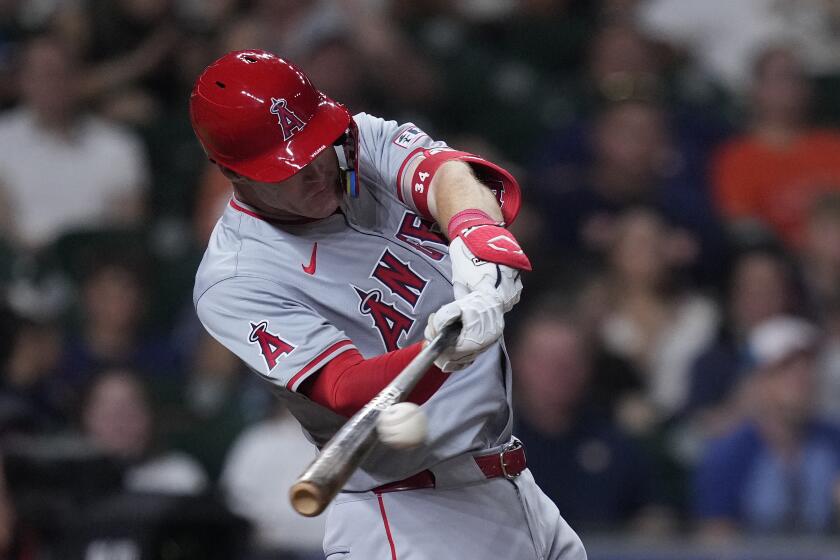NCAA ‘punitive measures’ against Penn State expected Monday
Penn State removed the statue of former coach Joe Paterno outside Beaver Stadium on Sunday in advance of NCAA sanctions that could cripple the football program for years.
The NCAA, a methodical and procedural organization not known for tipping its investigative hand, has scheduled a Monday morning news conference at which, it stated, it will levy “corrective and punitive measures” against the school because of the child sex abuse scandal that led to the conviction of former assistant coach Jerry Sandusky.
The penalties will be disclosed at the organization’s Indianapolis headquarters by NCAA President Mark Emmert and Ed Ray, chairman of the NCAA’s executive committee.
A Penn State spokesman reached Sunday said he had no information on the announcement.
The potentially extraordinary NCAA action comes less than two weeks after an investigation led by former FBI director Louis Freeh asserted that top officials at Penn State, including Paterno, agreed to cover up Sandusky’s abuses.
It is a contention Paterno’s family has vehemently denied. Paterno, who spent 61 years at the school and compiled a major-college-record 409 victories, died in January at age 85.
Sandusky was a longtime Paterno assistant who retained access to school facilities after his 1999 retirement from the coaching staff.
Speculation on the severity of Penn State’s sanctions moved furiously across multimedia and social networking outlets.
CBS News, quoting sources, reported Penn State would receive “unprecedented” punishment for its role in the scandal that has rocked college sports since November, when Sandusky was arraigned on charges that eventually led to his conviction on 45 counts involving 10 boys.
Yahoo reported the Penn State penalties would be “significant” and “staggering” and include a bowl ban and loss of scholarships.
The NCAA hasn’t banned a program from television appearances since 1996, but that remains one of the more punitive options.
Yahoo and ESPN, however, reported the sanctions would not require the school to shut down its famed football program.
The NCAA has not used the “death penalty” in football since it imposed a one-year ban on Southern Methodist in 1987 for a litany of violations, most involving payments to players by boosters.
The school elected not to play in 1988 and has since recorded only three winning seasons.
The Harrisburg (Pa.) Patriot-News reported Sunday that the impending sanctions against Penn State would not be appealed or “substantially challenged.”
Emmert, as NCAA president, has reportedly received unprecedented permission by the NCAA’s board of directors to bypass normal channels of enforcement to act in this case.
Penn State under Paterno, the school’s head coach from 1966 until his firing last November, was never cited for an NCAA violation.
Some are already questioning Emmert’s jurisdiction.
The Michael L. Buckner Law Firm, which serves as legal counsel for schools with cases before the NCAA committee, issued a statement saying it was “extremely concerned about the possible NCAA actions” and urged the organization to “comply with existing processes and procedures to address the Penn State sexual abuse scandal.”
In a PBS interview last week, Emmert did not rule out using the death penalty in outlining the parameters of the case.
“This is completely different than an impermissible benefits scandal like what happened at SMU, or anything else we’ve dealt with,” Emmert said. “…I don’t know what past precedent makes particularly good sense in this case, because it’s really an unprecedented problem.”
Dawn broke Sunday at Penn State with the removal of Paterno’s 7-foot, 900-pound statue, built in 2001 to commemorate the coach’s record-setting 324th victory.
Workers barricaded the streets and nearby sidewalks and covered Paterno’s likeness with a blue tarp. A bulldozer lifted Paterno’s statue off its moorings as an estimated 100 to 150 students chanted, “We are Penn State!”
Penn State President Rodney Erickson said he ordered the statue moved into storage because it had become a source of division.
“I believe that, were it to remain, the statue will be a recurring wound to the multitude of individuals across the nation and beyond who have been the victims of child abuse,” Erickson said in a released statement.
Erickson said Paterno’s name would remain on the school’s library that is a “tribute to Joe and Sue Paterno’s commitment to Penn State’s student body and academic success.”
Erickson added: “The world will be watching how Penn State addresses its challenges in the days ahead. While some may take issue with the decisions I have made, I trust that everyone associated with our University will respond in a civil and respectful manner.”
Joe Paterno’s family, in a statement, objected to the statue’s removal and the continued assault on Paterno’s legacy.
“Tearing down the statue of Joe Paterno does not serve the victims of Jerry Sandusky’s horrible crimes or help heal the Penn State Community,” the statement read in part. “We believe the only way to help the victims is to uncover the full truth. The Freeh report, though it has been accepted by the media as the definitive conclusion on the Sandusky scandal, is the equivalent of an indictment — a charging document written by a prosecutor — and an incomplete and unofficial one at that.”
Paterno’s statue was removed, coincidentally, six months from the day of his death.
More to Read
Go beyond the scoreboard
Get the latest on L.A.'s teams in the daily Sports Report newsletter.
You may occasionally receive promotional content from the Los Angeles Times.











